ms2:热力学性质的分子模拟工具,release 5.0
IF 3.4
2区 物理与天体物理
Q1 COMPUTER SCIENCE, INTERDISCIPLINARY APPLICATIONS
引用次数: 0
摘要
分子模拟工具ms2的新版本(5.0)(Deublein et al. 2011;Glass et al. 2014;Rutkai et al. 2017;Fingerhut et al. 2021)。ms2的5.0版本提供了8个统计集合,可以通过蒙特卡罗模拟获得纯流体和混合物。它为所有的系统引入了Lustig形式,允许实时采样任何与时间无关的热力学性质,如等时和等压热容、热膨胀系数、等温压缩系数、热压系数、声速或焦耳-汤姆逊系数。通过引入扩展的Axilrod-Teller-Muto势,可以实现三体相互作用,并结合改进的并行化方案。结合tang - toenies电位的扩展,这提供了一个高度精确的氪分子间电位。此外,实现了任意截止半径的截断移位Mie势,扩展了输运性质计算,并引入了确定布朗特征曲线的辅助工具。本文章由计算机程序翻译,如有差异,请以英文原文为准。
ms2: A molecular simulation tool for thermodynamic properties, release 5.0
A new version release (5.0) of the molecular simulation tool (Deublein et al. 2011; Glass et al. 2014; Rutkai et al. 2017; Fingerhut et al. 2021) is presented. Version 5.0 of features the eight statistical ensembles that are accessible via Monte Carlo simulation for pure fluids and mixtures. It introduces the Lustig formalism for all ensembles which allows on-the-fly sampling of any time-independent thermodynamic property, such as isochoric and isobaric heat capacities, thermal expansion coefficient, isothermal compressibility, thermal pressure coefficient, speed of sound or Joule-Thomson coefficient. Through the introduction of an extended Axilrod-Teller-Muto potential, three-body interactions become available, also incorporating an improved parallelization scheme. In combination with an extension of the Tang-Toennies potential, this provides a highly accurate intermolecular potential for krypton. Moreover, a truncated and shifted Mie potential for arbitrary cutoff radii is implemented, transport property calculations are extended and an auxiliary tool for the determination of Brown's characteristic curves is introduced.
求助全文
通过发布文献求助,成功后即可免费获取论文全文。
去求助
来源期刊

Computer Physics Communications
物理-计算机:跨学科应用
CiteScore
12.10
自引率
3.20%
发文量
287
审稿时长
5.3 months
期刊介绍:
The focus of CPC is on contemporary computational methods and techniques and their implementation, the effectiveness of which will normally be evidenced by the author(s) within the context of a substantive problem in physics. Within this setting CPC publishes two types of paper.
Computer Programs in Physics (CPiP)
These papers describe significant computer programs to be archived in the CPC Program Library which is held in the Mendeley Data repository. The submitted software must be covered by an approved open source licence. Papers and associated computer programs that address a problem of contemporary interest in physics that cannot be solved by current software are particularly encouraged.
Computational Physics Papers (CP)
These are research papers in, but are not limited to, the following themes across computational physics and related disciplines.
mathematical and numerical methods and algorithms;
computational models including those associated with the design, control and analysis of experiments; and
algebraic computation.
Each will normally include software implementation and performance details. The software implementation should, ideally, be available via GitHub, Zenodo or an institutional repository.In addition, research papers on the impact of advanced computer architecture and special purpose computers on computing in the physical sciences and software topics related to, and of importance in, the physical sciences may be considered.
 求助内容:
求助内容: 应助结果提醒方式:
应助结果提醒方式:


